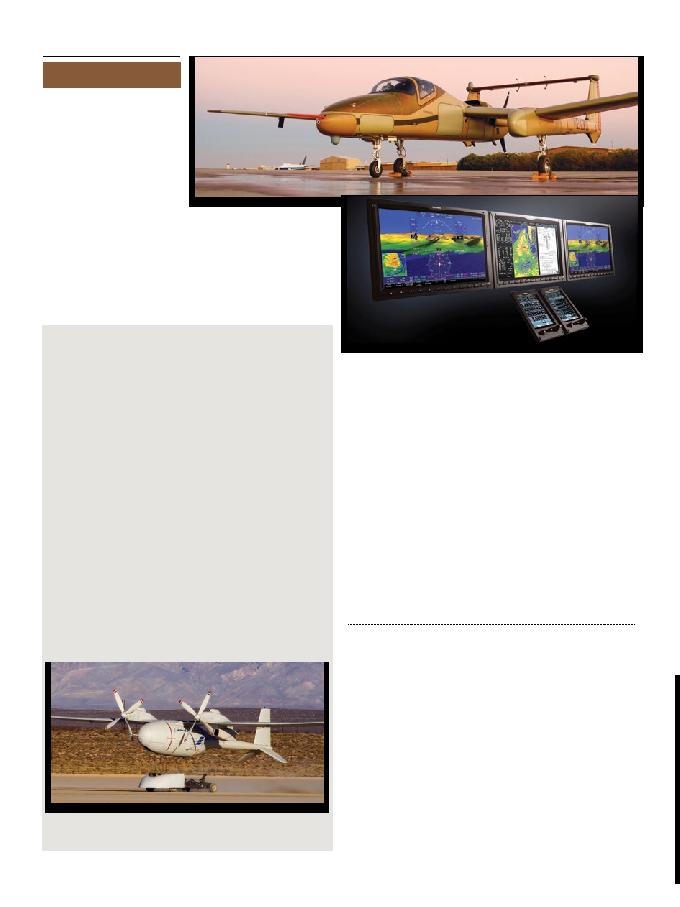
26
GA
/ Vol. 5 / No.4 / APRIL 2013
Defence News
Boeing's liquid hydrogen-powered
Phantom Eye unmanned airborne
system completed its second flight
Feb. 25, demonstrating capabilities
that will allow it to perform
intelligence, surveillance and
reconnaissance (ISR) missions for
up to four days without refueling.
During the flight, at NASA's
Dryden Flight Research Center at
Edwards Air Force Base, Calif.,
Phantom Eye climbed above an
altitude of 8,000 feet and remained
aloft for 66 minutes at a cruising
speed of 62 knots before landing. The
aircraft exceeded what it achieved
last year during its first flight when
it flew at an altitude of 4,080 feet
and remained aloft for 28 minutes.
"Today's combination of
geopolitical and economic issues
makes Phantom Eye's capabilities,
affordability and flexibility very
attractive to our global customers,"
said Darryl Davis, Boeing
Phantom Works president. "No
other system holds the promise
of offering on-demand, persistent
ISR and communications to
any region in the world, rapidly
responding to natural disasters
and national security issues."
Boeing is self-funding
development of the environmentally
responsible Phantom Eye, which
generates only water as a byproduct
of its propulsion system.
"This flight, in a more
demanding high-altitude flight
envelope, successfully demonstrated
Phantom Eye's maneuverability,
endurance and landing capabilities,"
said Drew Mallow, Phantom
Eye program manager.
Following the first flight, Boeing
upgraded the aircraft's software and
hardware, including the landing
gear. The upgrades paid off in the
form of a picture-perfect landing.
The Phantom Eye demonstrator
is capable of carrying a 450-pound
payload while operating for
up to four days at altitudes
of up to 65,000 feet. ˇ
High-altitude, long-endurance
demonstrator climbs above 8,000 feet
Boeing's liquid hydrogen-powered Phantom Eye unmanned airborne
system completed its second flight Feb. 25, demonstrating capabilities
that will allow it to perform intelligence, surveillance and reconnaissance
(ISR) missions for up to four days without refueling.
Northrop Grumman
selects GarminŽ
Integrated Flight Deck
for new optionally-
piloted aircraft
Garmin International Inc. has an-
nounced that Northrop Grumman
Corporation had selected Garmin to
supply the avionics suite for the new
Firebird, an optionally-piloted vehicle
(OPV) designed for intelligence,
surveillance and reconnaissance (ISR)
missions. The Firebird is equipped with
a tailored version of Garmin's latest
touchscreen-controlled integrated flight
deck system, leveraging the expand-
able and scalable attributes of Garmin's
commercial avionics technology to
yield a highly-capable Commercial
Off-the-Shelf (COTS) solution.
The Firebird cockpit is equipped
with three 14-inch, high-definition,
widescreen displays. Multi-pane
display capability effectively doubles
the number of different presentations
that the crew can control and view at
the same time. This allows for primary
flight information to be displayed
to both the pilot and copilot along
with additional displays capable
of showing sensor data, moving
maps, charts, engine indications and
other important flight information.
In addition, the cockpit is equipped
with two touchscreen display/
controllers that provide a centralized
and intuitive interface to the system,
giving pilots rapid access to the flight
information they want. The touch
controllers also allow for the control
of external missions systems.
For enhanced situational
awareness and hazard avoidance,
the Firebird is also equipped with
Garmin's Synthetic Vision
Technology (SVTTM), which presents
a 3D depiction of terrain, obstacles,
traffic and the runway environment
on the flight displays. Garmin's GWX
70 Doppler-capable weather radar
and Garmin's GTSTM 850 Traffic and
Collision Avoidance System (TCAS
I) are also on board the aircraft to
provide the best possible picture
of the operational environment.
The triple widescreen displays,
dual touchscreen display/controllers
and flight management systems
are also used in the ground control
station that is used to fly the
aircraft when it is operated as an
Unmanned Aerial Vehicle (UAV).
As a hybrid between a conventional
aircraft and a UAV, the Firebird offers
the flexibility to perform ISR missions
based on the demands of the mission
environment and whether manned
or unmanned flight is optimal. The
Firebird can support multiple types
of ISR and communications sensor
payloads simultaneously during flight
including high definition full-motion
video, infrared, radar and different
types of electronic communications.
The Firebird made its first
flight in November 2012
The Dubai Air Show takes place 17 to
21 November 2013 at its new purpose
built home at Dubai World Central
(DWC), located in Jebel Ali, Dubai.
F&E Aerospace organisers of
the Dubai Air Show are currently
preparing for what they are forecasting
to be the biggest show in their 26
year history, with expected crowds
of up to 60,000 attendees and over
1,000 exhibitors - which include 80
defence companies signed to date.
Returning exhibitor Honeywell
shared this positive outlook by
increasing their presence at the show
with an outdoor chalet and indoor stand.
Meanwhile Boeing's president,
Jeffery Johnson also revealed his
optimistic view for the November
confirming Boeing's commitment
to continued partnership with
Arab governments, enterprises
and customers in their long-term
plans to develop regional aerospace
infrastructure and capabilities.
The Dubai Airshow is organised
under the patronage of HH Sheikh
Mohammed bin Rashid Al Maktoum,
Vice President and Prime Minister
of the UAE and Ruler of Dubai
and Minister of Defence, also in
co-operation with Dubai Civil
Aviation Authority, Dubai Airports
and the UAE Armed Forces. ˇ
Defence industry looking ahead to the
Dubai Air Show in November

